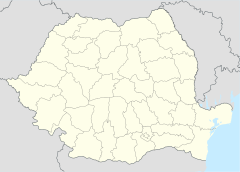
Suceava is a municipality and the namesake county seat town of Suceava County, situated in the historical regions of Bukovina and Moldavia, northeastern Romania and at the crossroads of Central and Eastern Europe respectively. It is the largest urban settlement of Suceava County, with a population of 84,308 inhabitants according to the 2021 Romanian census.

Vatra Dornei is a town in Suceava County, north-eastern Romania. It is situated in the historical region of Bukovina. Vatra Dornei is the fifth largest urban settlement in the county, with a population of 12,578 inhabitants, according to the 2021 census.

Rucăr is a commune located in the north-eastern part of Argeș County, Romania, situated in the Carpathian Mountains. The commune is composed of two villages, Rucăr and Sătic, and its population as of 2021 was 5,259. Historically important for its role as a border region between Wallachia and its neighboring countries, it is today popular with tourists from Bran Castle.

Niculițel is a commune in Tulcea County, Northern Dobruja, Romania. It is composed of a single village, Niculițel.

Broșteni is a town in Suceava County, in the historical region of Western Moldavia, northeastern Romania. Broșteni is the fourteenth largest urban settlement in the county, with a population of 5,179 inhabitants, according to the 2021 census. It was declared a town in 2004, along with seven other localities in Suceava County. The town administers the former villages of Hăleasa, Lungeni, and Neagra, and Cotârgași, Dârmoxa, Frasin, Holda, Holdița, and Pietroasa.
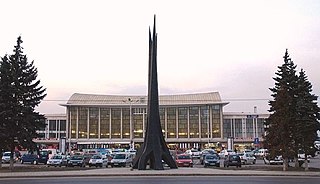
The Brașov railway station is the main station in Brașov, Romania. The building on the current location was opened to traffic in 1962. The station's bell chimes preceding the announcements represent a few notes from Ciprian Porumbescu's operetta Crai Nou.

Cocoş Monastery is a monastery in Romania, located in a forest clearing 6 km south of the town Niculițel.

Suceava North railway station, also known as Ițcani, is a railway station located in Suceava, Romania, completed in 1871. Originally part of Ițcani village, it is located at No. 4, Gării Street. The railway station was included on the 2004 list of historical monuments in Suceava County.
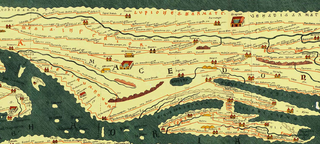
Amutria was a Dacian town close to the Danube and included in the Roman road network, after the conquest of Dacia.

The National Register of Historic Monuments (Romanian: Lista Monumentelor Istorice (LMI)) is the official English name of the Romania government's list of national heritage sites known as Monumente istorice. In Romania, these include sites, buildings, structures, and objects considered worthy of preservation due to the importance of their Romanian cultural heritage. The list, created in 2004, contains places that have been designated by the Ministry of Culture and National Patrimony of Romania and are maintained by the Romanian National Institute of Historical Monuments, as being of national historic significance.
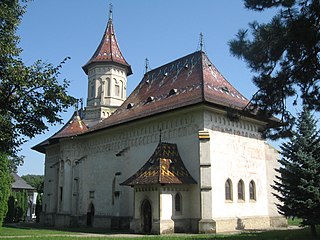
Saint John the New Monastery is a Romanian Orthodox monastery in Suceava, Romania. Built between 1514 and 1522, the monastery church is one of eight buildings that make up the churches of Moldavia UNESCO World Heritage Site, and is also listed as a historic monument by the country's Ministry of Culture and Religious Affairs. Its construction began during the reign of voivode Bogdan III the One-Eyed of Moldavia, after the nearby Mirăuți Church was devastated in 1513. The construction was completed by Stephen IV of Moldavia. The monastery church served as metropolitan cathedral of Moldavia until 1677 and, since 1991, it serves as the cathedral of the Archdiocese of Suceava and Rădăuți. The church is dedicated to Saint George and it has frescoes painted on the outside, typical of the region.

Probota Monastery is a Romanian Orthodox monastery in Probota village, Dolhasca town, Suceava County, Romania. Built in 1530, with Peter IV Rareș as ktitor, it is one of eight buildings that make up the Churches of Moldavia UNESCO World Heritage Site, and is also listed as a historic monument by the country's Ministry of Culture and Religious Affairs.
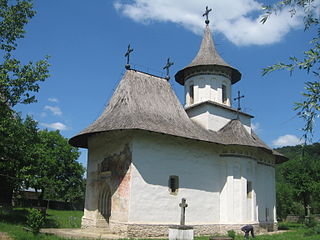
The Church of the Elevation of the Holy Cross is a Romanian Orthodox church in Pătrăuți Commune, Suceava County, Romania. Built in 1487, with Stephen III of Moldavia as ktitor, it is one of eight buildings that make up the churches of Moldavia UNESCO World Heritage Site, and is also listed as a historic monument by the country's Ministry of Culture and Religious Affairs.
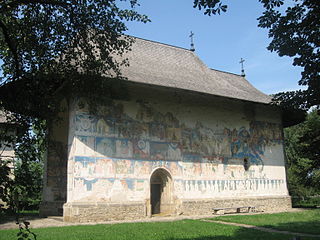
The Arbore Church is a Romanian Orthodox monastery church in Arbore Commune, Suceava County, Romania. Built in 1502 by Luca Arbore, and dedicated to the Beheading of St. John the Baptist, it is one of eight buildings that make up the churches of Moldavia UNESCO World Heritage Site. It is also listed as a historic monument by the country's Ministry of Culture and Religious Affairs.

Ițcani is a neighbourhood of Suceava, the county seat town of Suceava County in the historical region of Bukovina, northeastern Romania, located some 5 km northwest of the town center. Ițcani was initially established in the 15th century, following a 1453 document issued by Alexăndrel, Domn of Moldavia.
Tazlău Monastery is a Romanian Orthodox Christian monastery located at 188 Ștefan cel Mare Street, Tazlău, Neamț County, Romania.

Popăuţi Monastery is a monastery located in Botoșani, Romania, on Ştefan cel Mare Street no. 41, near the train station. It was founded in 1496 by the voivode Stephen the Great (1457-1504).

Iosefin is a historic district in western Timișoara. It was founded during the mid-18th century, at the beginning being just a village of German settlers, located on the outskirts of the walls of the Timișoara Fortress. Its name comes from that of Emperor Joseph II, during whose reign it was founded. Unlike most of the other Timișoara districts, the historic Iosefin is not divided into further districts or residential areas. However, mostly in the 1970s, numerous new development areas with their own names emerged on the southern edge of Iosefin. They are called Dâmbovița, Șagului Vest I, Șagului Vest II and Steaua. Iosefin is twinned with Vienna's Josefstadt and Budapest's Józsefváros.

Eudoxiu Hurmuzachi National College is a high school located at 5 Bucovinei Way, Rădăuți, Romania.


